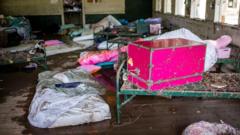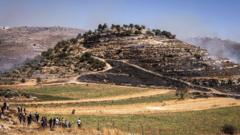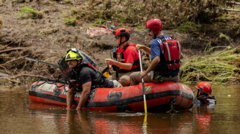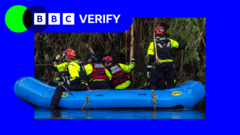As rescue efforts continue after severe flash floods that claimed 96 lives in Texas, officials are under growing pressure to explain their delayed emergency alerts. Kerrville residents report not receiving timely warnings, with many still missing.
Questions Arise Over Emergency Alerts During Texas Floods
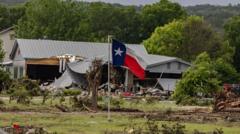
Questions Arise Over Emergency Alerts During Texas Floods
Official scrutiny heightens as Texas authorities face backlash over emergency communication failures during devastating floods that left 96 dead.
The article text:
Texas officials are grappling with increasing scrutiny concerning the timing of emergency alerts issued to residents during catastrophic flash floods that have resulted in the tragic deaths of 96 individuals and left over 160 still unaccounted for. As questions mount about potential failures in police radio communications, Kerrville Police community services officer Jonathan Lamb stated at a Thursday press conference, "I don't have any information to that point."
The intense questioning followed a critical exchange the day before, where reporters pressed officials about possible delays in their emergency response system. In the early hours of Friday morning, the Guadalupe River swelled dramatically, following an unprecedented rainfall of approximately 100 billion gallons. The impact of the floods was felt most severely in Kerr County, encompassing Kerrville, where 96 lives were lost, including the heartbreaking loss of 36 children from a nearby Christian camp. Officials are facing tough inquiries regarding the reasons behind such a catastrophic outcome.
An audio recording acquired by an ABC News affiliate revealed that a firefighter upstream from Kerrville had alerted the Kerr County Sheriff's Office at 04:22 local time on July 4, seeking an immediate deployment of alerts for passengers in low-lying areas as rising floodwaters threatened their safety. However, those notifications did not reach residents until nearly six hours later, exposing individuals to the full force of the deluge that would engulf them. The first alert from the county's CodeRED system, according to reports, did not reach residents until roughly 90 minutes after that initial call for help.
"The Guadalupe Schumacher sign is underwater on State Highway 39," the firefighter expressed in a dispatch call. "Is there any way we can send a CodeRED out to our Hunt residents, asking them to find higher ground or stay home?" The response from the dispatcher emphasized bureaucratic procedures over immediate action, asking the firefighter to remain patient while they sought supervisory approval.
During Wednesday's press conference, Kerr County Sheriff Larry Leitha acknowledged that he first became aware of the situation around "four to five area," and maintained that establishing a precise timeline of events would take time. He intimated that his primary focus was currently on locating the missing and identifying deceased victims. As of Thursday morning, more than 160 individuals were still unaccounted for, including campers and staff from Camp Mystic.
As rescue missions neared a standstill, with no additional survivors found since the floods occurred, officials pointed to several factors contributing to the tragic circumstances. Earlier weather notices had been issued, prompting the National Weather Service to warn of potential flooding beginning Thursday afternoon, and the Texas Division of Emergency Management mobilized state resources in anticipation of the storm.
Nonetheless, they cited lack of cell service and a widespread public complacency towards emergency alerts in a region prone to frequent flooding, ultimately leading to many residents not evacuating in time. In response to the crisis, President Donald Trump granted a federal disaster declaration upon Governor Greg Abbott's request, allowing the Federal Emergency Management Agency to assist in recovery efforts and establish a disaster recovery center in Kerr County.
The ongoing rescue missions involve more than 2,100 personnel from various agencies, alongside equipment including private helicopters, drones, boats, and cadaver dogs, all tirelessly working to locate both the missing and those buried beneath mounds of debris. Lt Colonel Ben Baker of the Texas Parks & Wildlife Department acknowledged the painstaking and hazardous nature of search operations, as rescuers sift through hazardous conditions to find victims. "It's extremely treacherous, time-consuming. It's dirty work," he explained. "So, we're having to go layer by layer, peeling these off, to make those recoveries."
Texas officials are grappling with increasing scrutiny concerning the timing of emergency alerts issued to residents during catastrophic flash floods that have resulted in the tragic deaths of 96 individuals and left over 160 still unaccounted for. As questions mount about potential failures in police radio communications, Kerrville Police community services officer Jonathan Lamb stated at a Thursday press conference, "I don't have any information to that point."
The intense questioning followed a critical exchange the day before, where reporters pressed officials about possible delays in their emergency response system. In the early hours of Friday morning, the Guadalupe River swelled dramatically, following an unprecedented rainfall of approximately 100 billion gallons. The impact of the floods was felt most severely in Kerr County, encompassing Kerrville, where 96 lives were lost, including the heartbreaking loss of 36 children from a nearby Christian camp. Officials are facing tough inquiries regarding the reasons behind such a catastrophic outcome.
An audio recording acquired by an ABC News affiliate revealed that a firefighter upstream from Kerrville had alerted the Kerr County Sheriff's Office at 04:22 local time on July 4, seeking an immediate deployment of alerts for passengers in low-lying areas as rising floodwaters threatened their safety. However, those notifications did not reach residents until nearly six hours later, exposing individuals to the full force of the deluge that would engulf them. The first alert from the county's CodeRED system, according to reports, did not reach residents until roughly 90 minutes after that initial call for help.
"The Guadalupe Schumacher sign is underwater on State Highway 39," the firefighter expressed in a dispatch call. "Is there any way we can send a CodeRED out to our Hunt residents, asking them to find higher ground or stay home?" The response from the dispatcher emphasized bureaucratic procedures over immediate action, asking the firefighter to remain patient while they sought supervisory approval.
During Wednesday's press conference, Kerr County Sheriff Larry Leitha acknowledged that he first became aware of the situation around "four to five area," and maintained that establishing a precise timeline of events would take time. He intimated that his primary focus was currently on locating the missing and identifying deceased victims. As of Thursday morning, more than 160 individuals were still unaccounted for, including campers and staff from Camp Mystic.
As rescue missions neared a standstill, with no additional survivors found since the floods occurred, officials pointed to several factors contributing to the tragic circumstances. Earlier weather notices had been issued, prompting the National Weather Service to warn of potential flooding beginning Thursday afternoon, and the Texas Division of Emergency Management mobilized state resources in anticipation of the storm.
Nonetheless, they cited lack of cell service and a widespread public complacency towards emergency alerts in a region prone to frequent flooding, ultimately leading to many residents not evacuating in time. In response to the crisis, President Donald Trump granted a federal disaster declaration upon Governor Greg Abbott's request, allowing the Federal Emergency Management Agency to assist in recovery efforts and establish a disaster recovery center in Kerr County.
The ongoing rescue missions involve more than 2,100 personnel from various agencies, alongside equipment including private helicopters, drones, boats, and cadaver dogs, all tirelessly working to locate both the missing and those buried beneath mounds of debris. Lt Colonel Ben Baker of the Texas Parks & Wildlife Department acknowledged the painstaking and hazardous nature of search operations, as rescuers sift through hazardous conditions to find victims. "It's extremely treacherous, time-consuming. It's dirty work," he explained. "So, we're having to go layer by layer, peeling these off, to make those recoveries."





